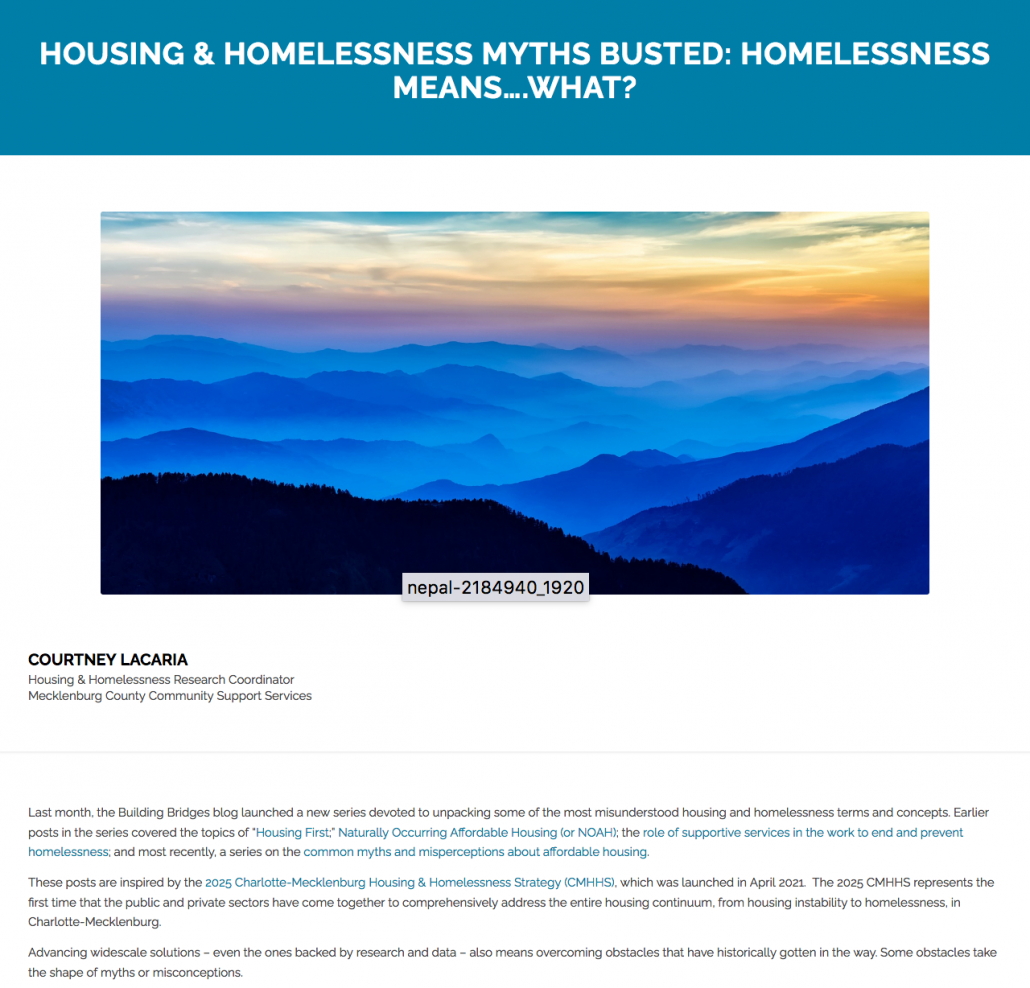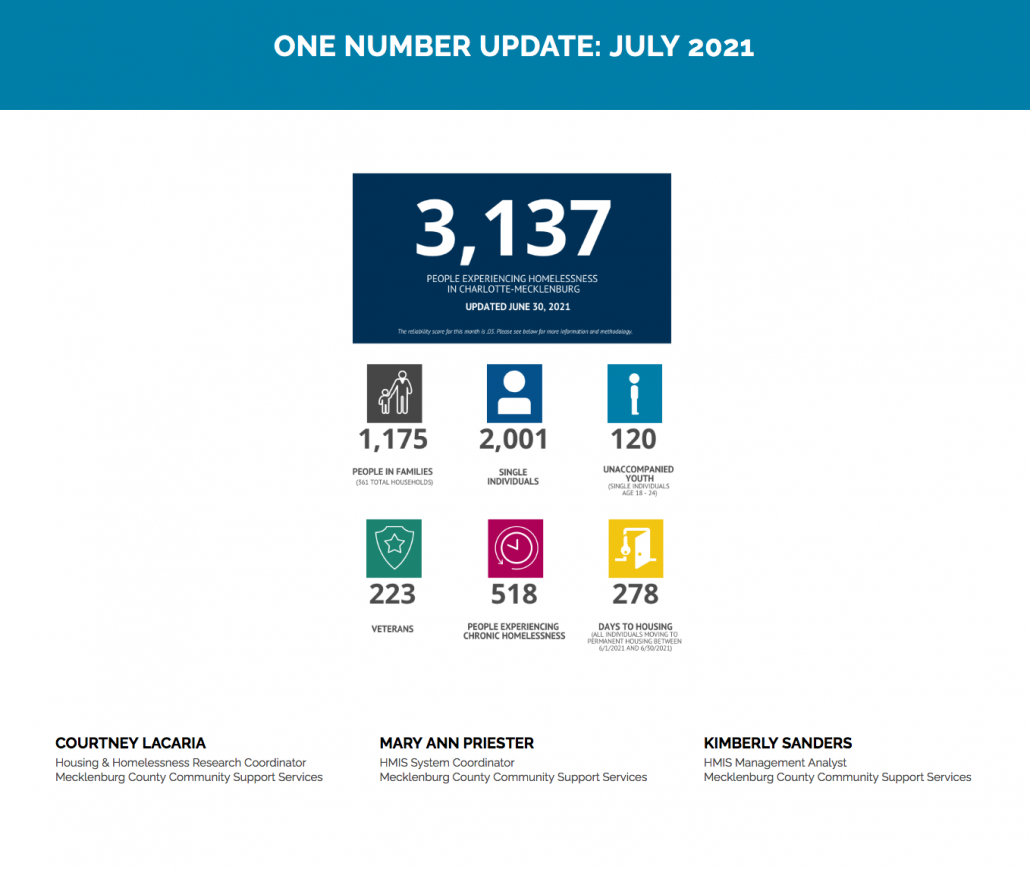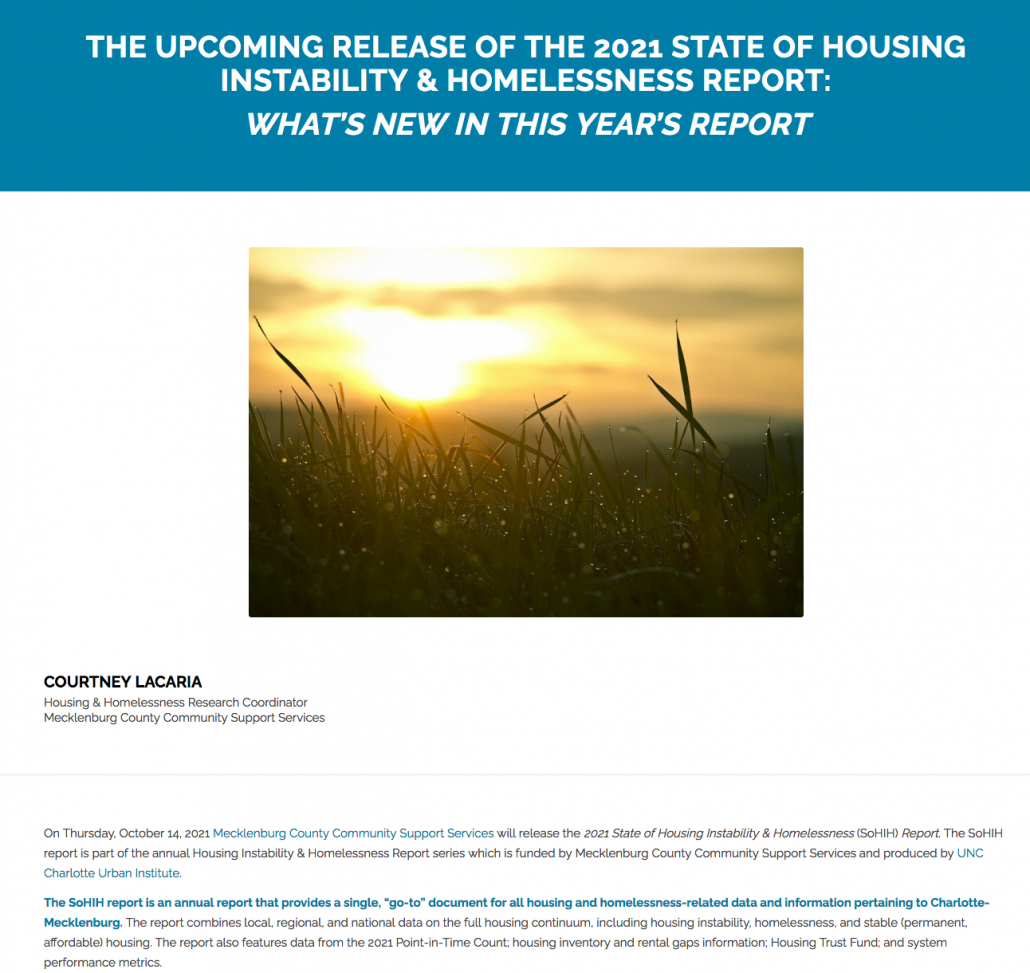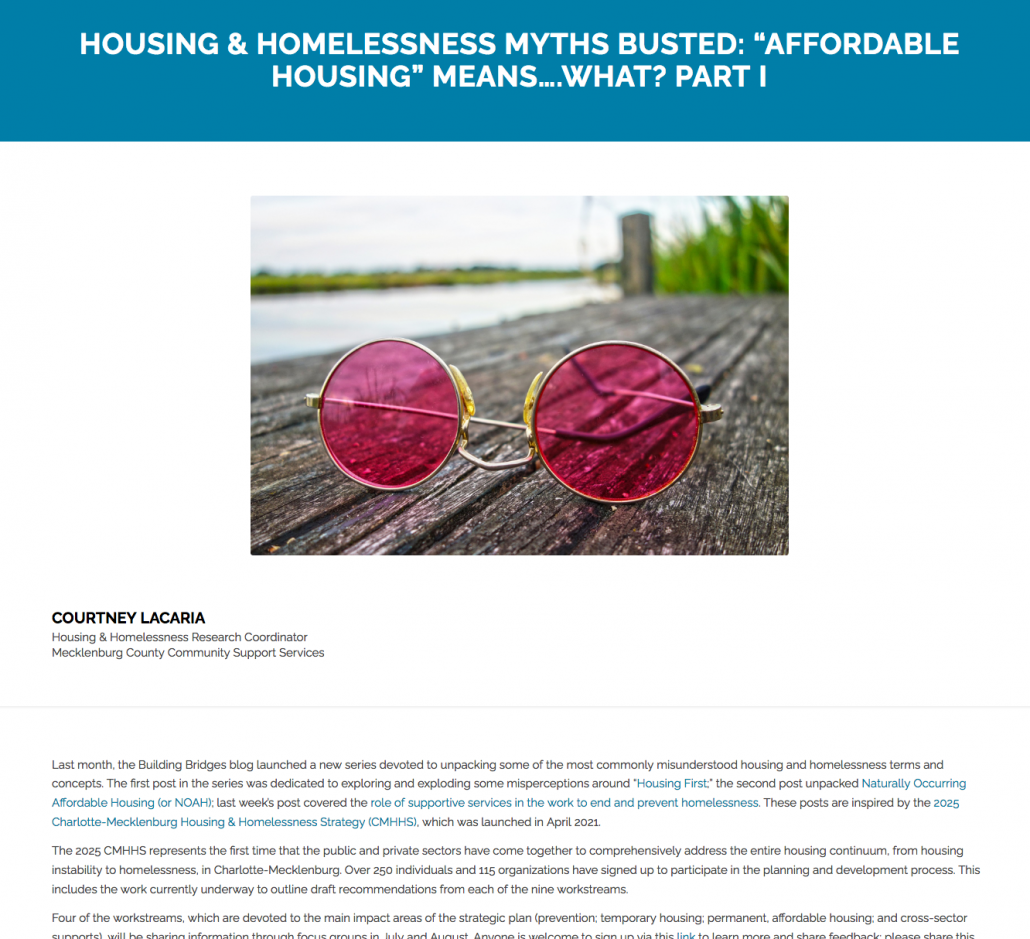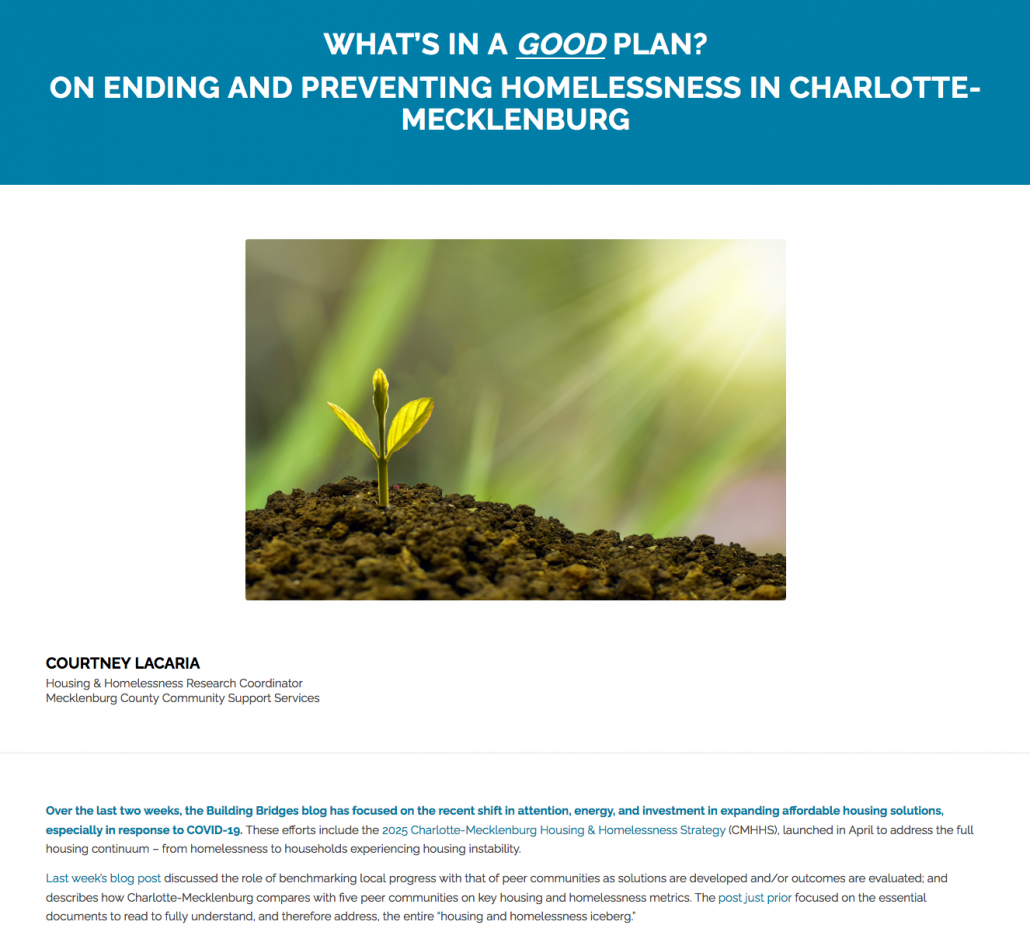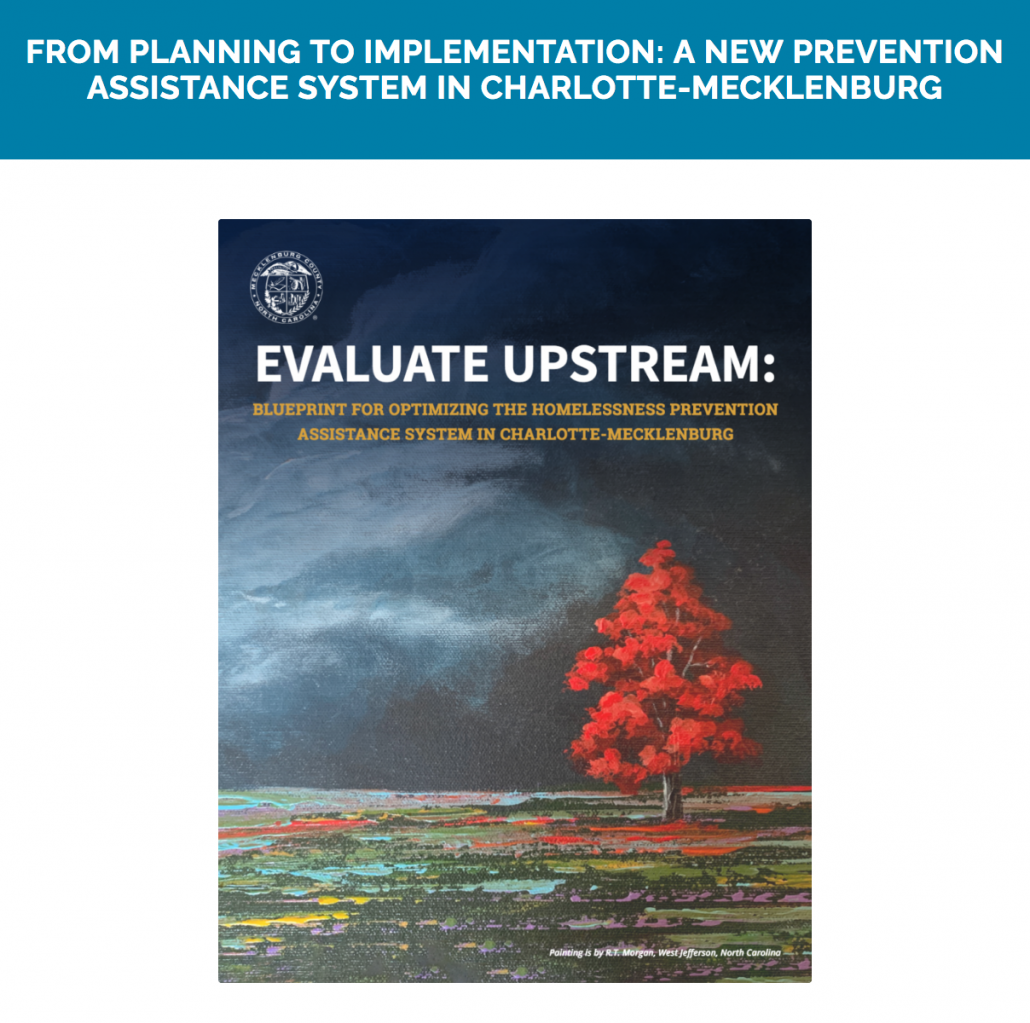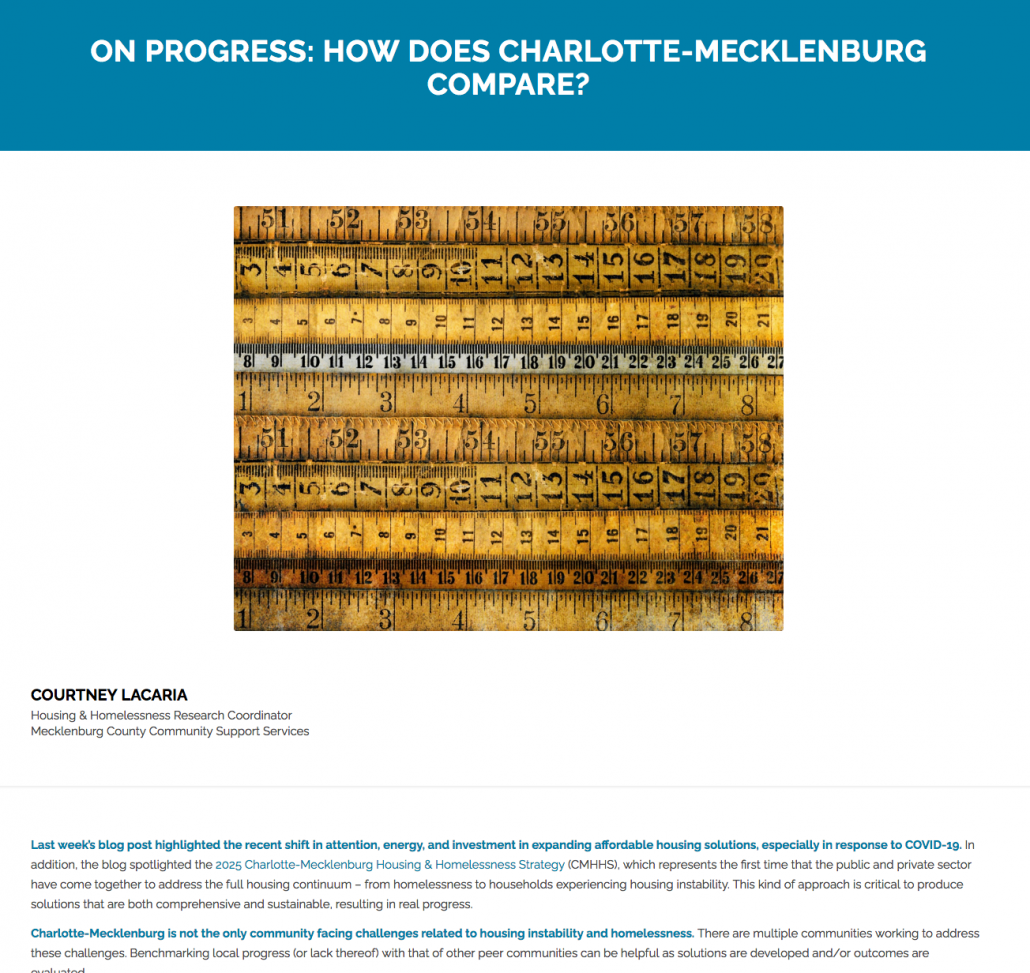Courtney LaCaria
Housing & Homelessness Research Coordinator
Mecklenburg County Community Support Services
During 2021, the Charlotte-Mecklenburg Housing & Homelessness Dashboard published 49 blog posts covering an array of topics, including new system-focused efforts in the community to address homelessness; combatting myths and misconceptions that stall progress; new report releases (and what they mean for the community); and local data and trends information. Throughout the year, more than 21,400 individuals accessed the Dashboard; this was nearly double the amount from the year prior. There were over 56,000 pageviews as a result.
In case you missed any of it, this first blog post of 2022 is dedicated to the top ten posts (as measured by discrete views) from 2021. Below are summaries; links to the “top ten” posts; and the “so, what” for Charlotte-Mecklenburg to consider as we forge ahead into 2022:
THE TOP TEN BLOG POSTS FROM 2021
Housing & Homelessness Myths Busted Series
Launched in September, this new series was inspired by the work of the 2025 Charlotte-Mecklenburg Housing & Homelessness Strategy (CMHHS). The series focused on unpacking some of the commonly misunderstood housing and homelessness terms and concepts. Posts covered the topics of “housing first;” Naturally Occurring Affordable Housing (or NOAH); definition and role of supportive services; deeply affordable housing (targeting households with income at or below 30% of Area Median Income); definition of homelessness (all definitions and current numbers); and lastly, the link between housing instability and homelessness (and why this link matters to effectively address either).
Local Housing & Homelessness Data Updates
For over a year, Mecklenburg County Community Support Services has been regularly updating local data on housing instability and homelessness, including the One Number and Coordinated Entry data on the Housing Data Snapshot, a hub for the latest numbers related to housing and homelessness in Charlotte-Mecklenburg. In addition to regular data updates, new features were added that allow the breakdown of One Number data by race and ethnicity, age, and gender. Finally, a new monthly data update was launched in July, expanding beyond a singular focus on the One Number to a more comprehensive data snapshot. This system-focused data approach attempts to cover the full housing continuum, from housing instability to homelessness in order to identify the households “in the gap” to understand both the need for services and to construct effective solutions to address these needs.
2021 State of Housing Instability & Homelessness Report
Tied to the release of the 2021 State of Housing Instability & Homelessness (SoHIH) report on October 14, the Building Bridges blog published five posts featuring the report components, what they mean, and why they matter for the community. The SoHIH report is an annual report that provides a single, “go-to” document for all housing and homelessness-related data and information pertaining to Charlotte-Mecklenburg. The first post in the series describes what is covered in the 2021 SoHIH report, including what’s new; this is helpful to understand how the report is organized and where to find specific information. The second post covers the key findings (from a high level) in the report. The final three posts take a deeper dive into three key findings: 1) access and availability of permanent, affordable housing; 2) disproportionate impact on minority and low-income households; 3) exposing other forms of homelessness that have gone uncounted and/or unfunded.
Affordable Housing-focused Housing & Homelessness Myths Busted Series
This five-part mini-series, which is part of the housing and homelessness myth-busting series (see #1 above), covers the top 5 myths related to affordable housing. Myth 1 investigates the long-held idea that affordable housing means loss of neighborhood character; Myth 2 explores whether affordable housing equates to ugly buildings; Myth 3 looks at the misconception that affordable housing results in low quality structures; Myth 4 covers the idea that affordable housing results in higher crime rates; and Myth 5 focuses on the impact of affordable housing on property values. Posts include examples of solutions from other communities for Charlotte-Mecklenburg to consider. Ultimately (and unfortunately), as the final post in the series points out, when it comes to combatting myths, especially with regard to affordable housing, seeing is believing. According to a research completed by Appalachian State University on the public opinion of affordable housing and NIMBYism, the negative perception of affordable housing is often more powerful than the research that disproves it; however, once affordable housing is constructed in a neighborhood, the negative perceptions of affordable housing actually decrease. The challenge is for communities, like Charlotte-Mecklenburg, is to produce more examples for residents to see.
What’s in a Good Plan? On Ending & Preventing Homelessness in Charlotte-Mecklenburg
This blog post is focused on the elements that make a “good” housing strategic plan, highlighting examples from other communities and discussing what this could ultimately mean for Charlotte-Mecklenburg. The post is timely, given the recent shift in attention, energy, and investment in expanding affordable housing solutions, especially in response to COVID-19; and the system-focused efforts to address the problem including Evaluate Upstream, launched in May 2020 focused on prevention assistance; and the 2025 Charlotte-Mecklenburg Housing & Homelessness Strategy (CMHHS), launched in April to address the full housing continuum from homelessness to households experiencing housing instability.
2025 Charlotte-Mecklenburg Housing & Homelessness Strategy
The Building Bridges blog shared regular updates on the 2025 Charlotte-Mecklenburg Housing & Homelessness Strategy (CMHHS), beginning with the release of the system-focused, community effort in April. Supported by the public and private sectors, the vision of CMHHS is that homelessness is rare, brief, and non-recurring in Charlotte-Mecklenburg and that every person has access to permanent, affordable housing and the resources to sustain it. Progress updates in June, August and October, which included milestones and next steps, were provided by the co-chairs of the working group: Cathy Bessant, Vice Chair of Global Strategy at Bank of America, and Eugene A. Woods, President and CEO of Atrium Health. The latest update from October outlines what to expect regarding the release of the new strategy with Part 1 containing the Strategic Framework and Part 2 containing the Implementation Plan, which will include action steps and related funding requests for the recommendations.
Evaluate Upstream: Homelessness Prevention in Charlotte-Mecklenburg
Prior to COVID-19, Mecklenburg County Community Support Services submitted a Continuum of Care (CoC) planning grant to the U.S. Department of Housing & Urban Development (HUD) in order to develop a comprehensive and sustainable prevention assistance system for Charlotte-Mecklenburg. The need identified at that time was the same as it is when the work began: Charlotte-Mecklenburg has multiple organizations providing a range of prevention activities, but there is neither a unified strategy, nor a concerted effort to align the whole array of prevention resources to the needs of the populations at risk of experiencing homelessness. The COVID-19 pandemic (and subsequent assistance disbursed from the federal government to keep households from eviction) has only underscored the need for an optimized prevention assistance system that is complementary to the rest of the housing ecosystem. The Building Bridges blog posts in 2021 covered two major updates regarding Evaluate Upstream, the name for the year-long, community planning process that resulted. The update from January described the outcome of a 2-day design sprint attended by more than 40 individuals with diverse backgrounds, representing the public and private sectors. The design sprint represented a critical transition from the previous phases of work involving research, data collection, and systems mapping that would ultimately lay the foundation for the development of an effective, collaboratively designed prevention system. The May blog post shared an overview of the entire process and final output of the community planning work, including the crafting of a blueprint for a prevention assistance system and how the work would be incorporated into that of the Charlotte-Mecklenburg Housing & Homelessness Strategy (CMHHS).
The Longest Night of the Year
This final post for 2021 commemorates the winter solstice (a time to take stock from the previous year and seize the opportunity for new rays of hope to shine in new year), by spotlighting three examples from other communities who are trying different approaches to address housing instability and homelessness. The post also recognizes National Homeless Persons’ Memorial Day, when communities remember each of the individuals who have died while experiencing homelessness during the past year. Finally, the post argues that changing the trajectory of homelessness requires changing hearts: “knowing what the solutions are and how to assemble them in a plan for systemic change is essential. Executing such a plan effectively requires community ownership. It needs the community’s heart wanting the change more than settling for the status quo.”
The List: On Addressing the Housing & Homelessness Iceberg
Addressing complex problems like housing instability and homelessness can appear, at first, impossible. In fact, some communities choose to break the problem, focusing on an individual component such as chronic or veteran homelessness. Others choose to tackle what is visible, like unsheltered homelessness. But parsing the problem only perpetuates the cycle that prevents communities from actually making real progress. To engender systems-focused changes requires commitment and alignment on all levels. It also requires patience and persistence, maintaining a focus on what works and what is supported by research and data. At minimum, everyone can make a difference simply by listening and learning; by collectively building the community infrastructure that can propel both the message and the solutions forward. This blog post outlines all of the essential resources (local, regional and national) to help the community understand both the challenges and solutions related to housing instability and homelessness.
On Progress: How Does Charlotte-Mecklenburg Compare?
Charlotte-Mecklenburg is not the only community facing challenges related to housing instability and homelessness. There are multiple communities across the United States working to address these challenges. Benchmarking local progress (or lack thereof) with that of other peer communities can be helpful as solutions are developed and/or outcomes are evaluated. This blog post describes how Charlotte-Mecklenburg compares with five peer communities on key housing and homelessness metrics; and what this may ultimately mean for the community.
SO, WHAT
While housing instability and homelessness certainly predate the pandemic, communities across the United States have learned a particularly tough lesson: these are no longer simply a household’s housing issue, they are public health concerns with implications for the entire community. COVID-19 has exacerbated existing disparities while also exposing the “hidden homeless.” Fortunately, it has also forced the public and private sectors into action, and led to consideration of the implications of failing to address the full housing continuum. To protect public health, the choice to “fix” the pre-existing conditions of housing instability and homelessness is up to each of us. To all of us.
It’s already 2022: we made it. Why look back now? It can seem that the sheer act of reflecting upon the past year is painful. Taking stock of what has come (and gone) is complicated. It may feel easier just to keep our eyes looking ahead, hopeful in the promise of a fresh start in the new year. But, what happens if we just jump ahead, with no critical assessment of our work during the previous year, as difficult as it may be?
While we may be able to move forward, we will never be able to achieve real change without also spending time taking stock. What did we do last year that worked? What did we do differently that worked? Of those new, different things, what can we continue? Even if we can, should we? What do we need to stop doing now, and/or forever?
Perhaps the better question is why are we so intent on getting back to the way things used to be? What is even meant by “a return to normalcy?” Some things may never be the the same. And that, especially in the case of housing instability and homelessness, may be okay. We can build upon what we have had to change, and continue to improve. Different can be better. In fact, it may be just the thing we need.
SIGN UP FOR BUILDING BRIDGES BLOG
Courtney LaCaria coordinates posts on the Building Bridges Blog. Courtney is the Housing & Homelessness Research Coordinator for Mecklenburg County Community Support Services. Courtney’s job is to connect data on housing instability, homelessness and affordable housing with stakeholders in the community so that they can use it to drive policy-making, funding allocation and programmatic change.


